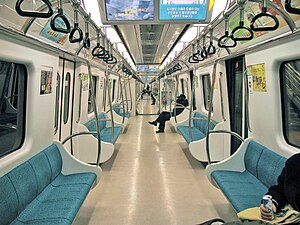Daejeon Metro
 | |||
 | |||
| Overview | |||
|---|---|---|---|
| Native name | 대전 도시철도 | ||
| Locale | Daejeon, South Korea | ||
| Transit type | Rapid transit | ||
| Number of lines | 1 | ||
| Number of stations | 22 | ||
| Daily ridership | 110,307 (2019) | ||
| Annual ridership | 40,262,211 (2019)[1] | ||
| Website | http://www.djet.co.kr/ | ||
| Operation | |||
| Began operation | 16 March 2006 | ||
| Operator(s) | Daejeon Metropolitan Express Transit Corporation | ||
| Number of vehicles | Hyundai Rotem Metro cars | ||
| Technical | |||
| System length | 22.74 km (14.13 mi) | ||
| Track gauge | 1,435 mm (4 ft 8+1⁄2 in) | ||
| |||
| Daejeon Metro | |
| Hangul | 대전 도시철도 |
|---|---|
| Hanja | 大田 都市鐵道 |
| Revised Romanization | Daejeon dosicheoldo |
| McCune–Reischauer | Taejŏn tosich'ŏlto |
Daejeon Metro | ||||||||||||||||||||||||||||||||||||||||||||||||||||||||||||||||||||||||||||||||||||||||||||||||||||||||||||||||||||||||||||||||||||||||||||||||||||||||||||||||||||||||||||||||||||||||||||||||||||||||||||||||||||||
|---|---|---|---|---|---|---|---|---|---|---|---|---|---|---|---|---|---|---|---|---|---|---|---|---|---|---|---|---|---|---|---|---|---|---|---|---|---|---|---|---|---|---|---|---|---|---|---|---|---|---|---|---|---|---|---|---|---|---|---|---|---|---|---|---|---|---|---|---|---|---|---|---|---|---|---|---|---|---|---|---|---|---|---|---|---|---|---|---|---|---|---|---|---|---|---|---|---|---|---|---|---|---|---|---|---|---|---|---|---|---|---|---|---|---|---|---|---|---|---|---|---|---|---|---|---|---|---|---|---|---|---|---|---|---|---|---|---|---|---|---|---|---|---|---|---|---|---|---|---|---|---|---|---|---|---|---|---|---|---|---|---|---|---|---|---|---|---|---|---|---|---|---|---|---|---|---|---|---|---|---|---|---|---|---|---|---|---|---|---|---|---|---|---|---|---|---|---|---|---|---|---|---|---|---|---|---|---|---|---|---|---|---|---|---|
| ||||||||||||||||||||||||||||||||||||||||||||||||||||||||||||||||||||||||||||||||||||||||||||||||||||||||||||||||||||||||||||||||||||||||||||||||||||||||||||||||||||||||||||||||||||||||||||||||||||||||||||||||||||||
| ||||||||||||||||||||||||||||||||||||||||||||||||||||||||||||||||||||||||||||||||||||||||||||||||||||||||||||||||||||||||||||||||||||||||||||||||||||||||||||||||||||||||||||||||||||||||||||||||||||||||||||||||||||||
Daejeon Metro (Korean: 대전도시철도; Hanja: 大田都市鐵道; RR: Daejeon dosicheoldo) is the rapid transit system of Daejeon, South Korea, operated by the Daejeon Metropolitan Express Transit Corporation (DjeT, or Daejeon Metro). The single-line subway network first opened in 2006 with 12 stations. The line was expanded in 2007 and it now consists of one line, 22 operating stations, and 22.6 kilometres (14.0 mi) of route.[citation needed]
History[]
After the city's administrative district was expanded in 1995, plans were announced in February 1996 for a five-line metro service totaling 102.3 kilometres (63.6 mi). Construction of Line 1 began in October 1996 and was scheduled to be completed by 2003, but completion was delayed by right-of-way acquisition and constrained finances in the wake of the 1997 Asian financial crisis.[2]
Lines[]
| Line Name | Line Name Hangul |
Starting Station(s) | Ending Station(s) | Stations | Total Length in km |
| Line 1 | 1호선 | Panam | Banseok | 22 | 22.7 |
Line 1[]
Line 1 was initially designed to be 22.6 kilometres (14.0 mi) long, connecting the old and new town centers.[2] It opened in two phases and a third is planned:
- 16 March 2006: Line 1 Phase 1 opened (Panam ↔ Government Complex)
- 17 April 2007: Line 1 Phase 2 complete, fully opened (Panam ↔ Banseok)
- 2029: Tentative opening date of extension from Banseok to Government Complex Sejong[3]
The track leads from Banseok Station in Yuseong-gu to Panam Station in Dong-gu.
Line 2[]
Line 2 has gone through a number of changes and proposals over the years, including making it a maglev modeled after the maglev in the National Science Museum.[4] In 2015, a basic plan was established and the following year they announced the route, which included two demonstration routes that would later be connected, one in an urban area and one in a business area.[5] It is still in the planning stage and is expected to open in 2027. It will be serviced as a streetcar and is called a tram(트램) at the same time as the Daejeon Subway Line 2.[6]
Network Map[]
See also[]
- Transportation in South Korea
- List of Korea-related topics
- List of metro systems
References[]
- ^ http://www.djet.co.kr/kor/board.do?menuIdx=541&bbsIdx=16268
- ^ Jump up to: a b Mun, Jinsu; Kim, Hun, eds. (2013). "2. History of the Urban Railway Development in South Korea". Korea's Railway Development Strategies. Goyang, Republic of Korea: Korean Transport Institute. pp. 30–31. ISBN 978-89-5503-559-9. Retrieved 22 May 2017.
- ^ 박, 희윤 (18 April 2019). 대전~세종 광역철도 건설…2029년 완공목표: 반석~정부세종청사 14㎞ 연결…2029년 완공목표, 국가철도망계획 반영 추진. 서울경제 (in Korean). Retrieved 25 April 2019.
- ^ 윤경찬 (14 April 2014). "대전도시철도 2호선 자기부상열차 주목". MC News (in Korean). Retrieved 7 September 2020.
- ^ "도시의 틀 바꿀 트램! 시범노선 2020년까지 완공한다". Daejeon City (in Korean). Retrieved 7 September 2020.
- ^ "대전도시철도 2호선 트램, 궁금증 풀어드립니다". 충청투데이 (in Korean). 2019-01-30. Retrieved 2021-06-05.
External links[]
| Wikimedia Commons has media related to Daejeon Subway. |
- Official website (in Korean)
- Official website (in English)
- Daejeon Real Distance Metro Map, CityRailTransit
- Daejeon Metro
- Transport in Daejeon
- Underground rapid transit in South Korea
- Train-related introductions in 2006
- South Korea rapid transit stubs

